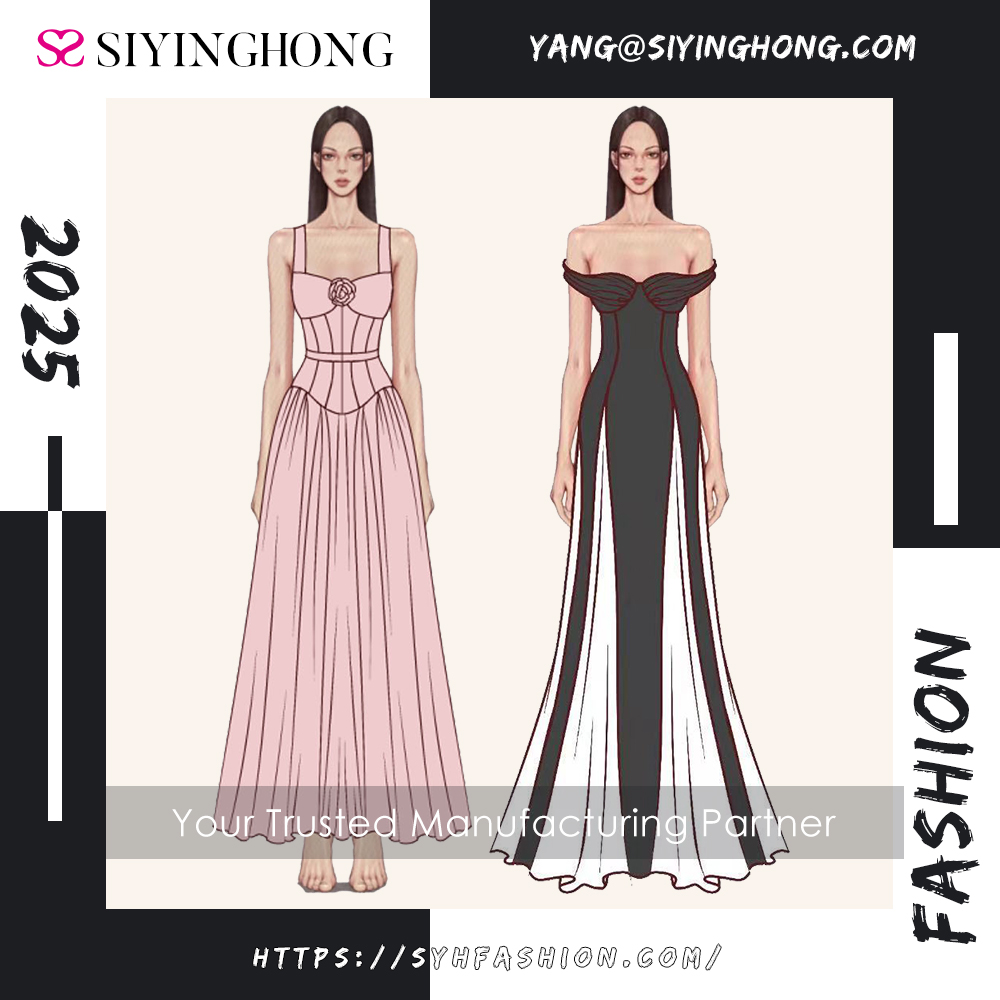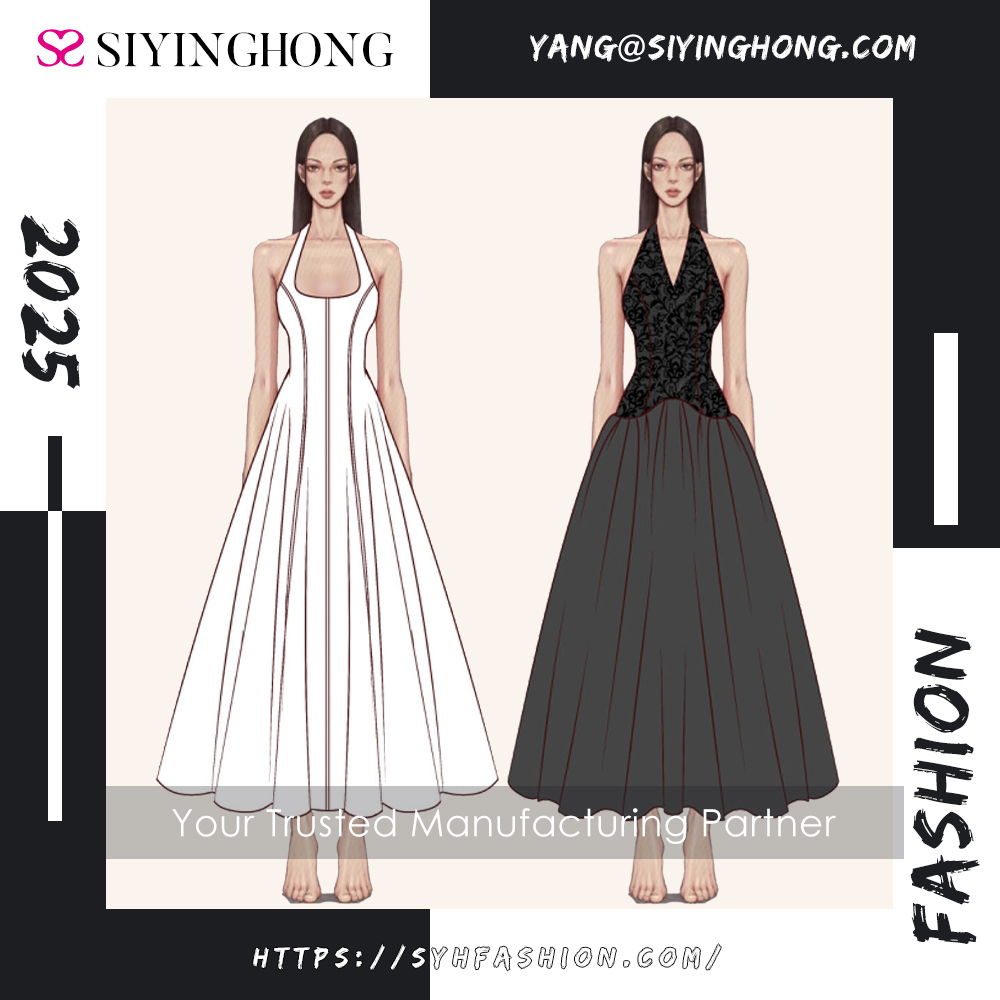1.The core advantage of the evening dress factory customization service: the art of balancing scale and personalization

(1)Price: the king of mass production of cost control gene
1) price depressions of industrial production
Cost structure differences: Factory customization relies on assembly line production (such as CAD plate-making and batch cutting), and the production cost of a single item can be reduced by 40% to 60%. For example, for the same satin fishtail skirt, the high-end custom-made price starts from 800 US dollars, and the factory custom-made price can be controlled within the range of 500 to 800 US dollars.
Bulk discount mechanism: For more than 50 custom-made items, you can enjoy tiered prices (for example, the unit price for 100 items is 80 US dollars, and for 100 items, it drops to 60 US dollars), suitable for bulk purchases by wedding dress stores, performance groups, etc.
2) High cost performance does not equal sacrificing quality
Factories often adopt the "machine + local manual" model: the main sewing is completed by industrial sewing machines (with an efficiency increase of 20 times), while key parts (such as the fishbone fixation of the corset and the embellishment of sequins) retain manual processes, taking into account both cost and texture.
(2)Speed delivery: from design to finished cycle compression
1) time advantage of the standardization process
● Production cycle comparison:
High-end customization: 3-6 months (including multiple manual adjustments)
Factory customization: 7-21 days (standard model), expedited service can be compressed to 3 days (an additional 30% expedited fee is required)
● Case:
A production team for a certain evening party needed 50 sets of evening gowns. The factory completed the delivery in 15 days through "modular production" (reserving universal hemlines and detachable decorations in advance), while it took 2 months for manual customization.
2) Rapid response of the in-stock pattern warehouse
The factory always keeps over 500 basic patterns (such as A-line skirts, fishtail skirts, cape styles, etc.) in stock. Customers can directly modify the details (such as adjusting the neckline, changing the fabric) in the pattern library without having to design from scratch, saving 50% of the pattern making time.
(3)Mass customization: batch needs accurate fit
1) group unity of customized solutions
● Size matrix management:
Provide "size packages" for teams (such as wedding bridesmaids and model teams), for example, customizing S/M/L in a ratio of 30%/50%/20% respectively, to ensure uniform style for all members and avoid visual unevenness caused by confusion in garment sizes.
● Detail standardization:
For instance, when customizing corporate year-end parties, the position of the embroidered logo can be uniformly determined, and the length error of the skirt hem should be no more than 1cm. Through quality control on the assembly line, the effect of "one hundred pieces consistent" can be achieved.
2) The supply chain advantages of cross-border customization
China's coastal dress factories (such as Dongguan Humen Siyinghong Garment Factory) rely on a complete industrial chain and can undertake ODM orders for overseas brands. For instance, customizing 1,000 sequined dresses for European customers only takes 45 days from fabric procurement to garment export, with a cost 35% lower than local production.
2.The flexible customization dimensions: mid-market personalized threshold
1) modular customization options
● The factory provides a "customized menu" for customers to select:
Basic items: Fabric (satin/lace/velvet), color (12 standard colors available), skirt style (fluffy/slim)
Upgrade items: Additional purchase of handcrafted beaded beads ($20 per square meter), custom inner lining embroidery ($30 per piece), detachable tail ($50 per piece)
● For example:
If the customer selects the combination of "red satin + A-line skirt + rhinestone at the waist", the factory can produce it within 3 days without the need for A high design fee.
2) Flexible production for small orders and quick responses
It supports a minimum order of 80 pieces (100 pieces + for traditional factories), making it suitable for small dress stores to try out new styles or for individual customers to customize "the same style as the best friend group", reducing inventory risks.
3.Supply chain integration: the fabric and craft of scale advantages
1) bulk fabric purchasing bargaining power
● The factory purchases over 1 million meters of fabric annually and can enjoy exclusive discounts from fabric suppliers. For instance, a regular merchant buys silk double fabric at 29 US dollars per meter, while the factory's purchase price is only 21 US dollars per meter. The cost advantage is directly reflected in the customized price.
● Inventory fabric clearance benefit: Customers can choose factory "leftover material customization" (such as remaining 50 meters of champagne-colored satin), with an additional 20% price reduction. This is suitable for customers who are not strict about color requirements.
2) A quality control system for standardized processes
Factories that have passed ISO9001 certification have set quantitative standards for details such as "residual thread ends ≤3 pieces per piece" and "zipper smoothness ≥98%". The qualification rate of ready-made garments is over 95%, which is much higher than the 70% qualification rate of small workshop customization.
4.Factory Customization vs. High-end Customization: A scenario-based Difference Table
| Dimension | Custom Services | High-end customized services |
| Price | $120- $1,500 (better for bulk orders) | 715- 142,857 + US dollars |
| MOQ | 80-100/piece | 1 item (Single room Haute couture) |
| Responsible for Core Process | Machines take the lead, with finishing work as an embellishment | 100% hand-stitched |
| Suitable scenarios | Wedding teams, corporate events, performance costumes | Red carpet, state banquets, collectible gowns |
| Design freedom | Modify based on the existing layout | Brand new original design |
● Factory-customized gold application scenarios: 3 types of demands are mandatory
1)Commercial bulk purchasing:
The wedding dress store needs to stock up on 20 dresses of different price ranges. The cost of each custom-made dress in the factory is within 250 US dollars, and it supports a small order replenishment model of "restocking after selling out".
2)Student/performance group:
100 sets of sequined gowns for the dance competition. The factory uses "uniform cutting + size sewing", with the unit price controlled within 75 US dollars per piece, and the team logo can be printed. The cost performance far exceeds rental.
3)Fast fashion brand ODM:
A fast-moving consumer goods brand has launched a "Dress Season" collection, entrusting a factory to customize 3,000 dresses. From design finalization to listing, it only takes 28 days, capturing market hotspots at a speed far exceeding handcrafted customization.
The essence of factory customization is to solve the "large-scale production of personalized demands" with an industrial mindset. While high-end customization is pursuing a "unique artistic sense", factory customization offers the possibility for the mass market to "wear tailor-made clothes for less money", especially suitable for commercial and group scenarios with clear requirements for cost performance and delivery speed.

5.Analysis of Global Evening Dress Trends: A Dual Variation of Technological Innovation and Cultural Narrative
(1) Color Revolution: From Low-saturation Dreams to High-saturation Dramas
1) A bipolar dialogue of warm and cool tones
● Low-saturation pastel color series:
Soft tones such as cream peach and bay green dominate everyday light gowns and vacation scenes, creating a "matte oil painting" texture through the layering of three-dimensional gauze and chiffon. For instance, cream peach-colored gowns are often paired with heavy embroidery or dragon patterns, achieving an international expression of "Oriental reserved aesthetics" through both Chinese and Western tailoring.
● High-saturation dramatic colors:
Intense hues such as flame red and electric blue become the focus of the red carpet. The visual impact is enhanced through contrasting colors (such as red and black combinations) and metallic luster fabrics (such as gilded satin). The designer breaks the monotony of solid colors through local highlight techniques (such as crystal inlays at the waist and gradient dyeing of the skirt hem), creating an effect of walking artworks.
2) Color translation of cultural symbols
Chinese elements drive the modern interpretation of the traditional color palette: The bay green blends the imagery of jadeite and jade, achieving a visual upgrade of "new Chinese style" through gold and silver thread embroidery or glass beads. The Middle East market prefers navy blue and deep purple, paired with hand-woven Arab patterns, to convey a sense of mystery and luxury.
(2) Material Innovation: Technology Empowerment and Sustainable Awakening
1) The explosion of futuristic fabrics
Smart fabric: Equipped with technological materials such as temperature-controlled fibers (which can adjust humidity according to body temperature) and LED light-emitting fibers (which can control the flashing mode through a mobile phone APP), it transforms the dress from a static decoration into a dynamic interactive carrier. For instance, the temperature-controlled gowns piloted in the North American market can remain comfortable in an environment ranging from -5 ℃ to 25℃, making them suitable for outdoor banquets.
Metallic luster and holographic materials: Fabrics such as mirror satin and laser sequins have become mainstream for party gowns, creating a flowing galactic effect through light refraction, and are particularly favored by consumers in 2024.
Post time: Jun-18-2025






